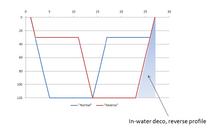scubawheels
Registered
I've heard some new thinking that reverse profile diving is not as dangerous as once thought. What are the thoughts of the ScubaBoard community in regards to reverse profile diving?
The reason for my question is this....Recently on a trip to the Straits of Mackinaw, we planned to complete two dives on two wrecks. The deck of the first, the Stalker, is at about 85 feet. The deck of the second wreck, the William Young, is around 105 feet. I felt no ill effects after the dives, other than disappointment because my second dive was very short; the William Young is one of the best wrecks in Mackinaw.
The reason for my question is this....Recently on a trip to the Straits of Mackinaw, we planned to complete two dives on two wrecks. The deck of the first, the Stalker, is at about 85 feet. The deck of the second wreck, the William Young, is around 105 feet. I felt no ill effects after the dives, other than disappointment because my second dive was very short; the William Young is one of the best wrecks in Mackinaw.





